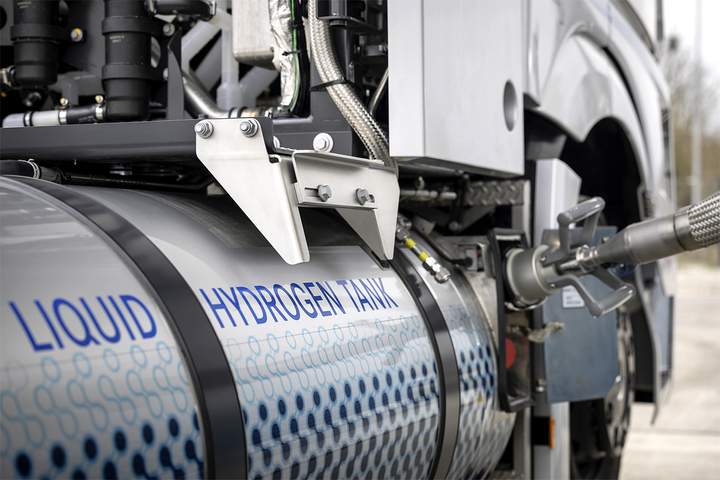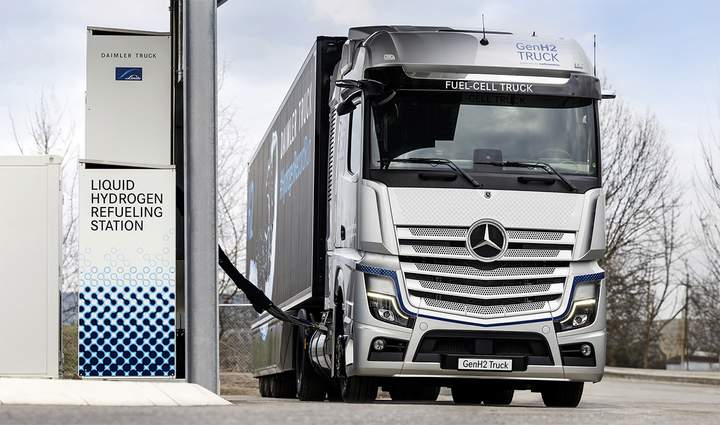The two patriarchs of mechanical engineering, Daimler Truck and Linde Engineering, are bringing to market a jointly developed, more economical and cheaper technology for refueling with supercooled liquid hydrogen sLH2.
Compared to gaseous hydrogen, supercooled liquid hydrogen (sLH2) offers higher storage density, longer range, faster refueling, lower costs and superior energy efficiency. That’s the short version, although in fact this decision was a long time coming.
As a result of this decision, Daimler Truck and Linde Engineering aim to establish sLH2 as the global refueling standard for hydrogen-powered trucks. They believe that this technology should not be commercially classified, but should be made open and, most importantly, accessible to all interested parties through the ISO standard.
The first sLH2 public fueling station was inaugurated in Wert am Rhein, Germany. Initially, it will be available to selected logistics customers from mid-2024 for test trials of Mercedes-Benz GenH2 Truck long-haul tractors with cargo semi-trailers.
“Zero-emission transportation requires three factors: the right electric and hydrogen vehicles, the right infrastructure network, and cost parity for ZEVs compared to diesel trucks. In terms of hydrogen infrastructure, we have reached an important milestone today: with sLH2, refueling with hydrogen is as convenient as refueling with diesel today. It takes about 10 to 15 minutes to refuel our Mercedes-Benz GenH2 Truck for a run of more than 1,000 kilometers,” said Andreas Horbach, Member of the Board of Management of Daimler Truck AG responsible for truck technology.
Today, we can state that two leading industrial companies have achieved an important infrastructure breakthrough on the way to decarbonizing transportation with hydrogen. Over the past few years, engineers from both companies have jointly developed sLH2, a new process for processing supercooled liquid hydrogen.
“Supercooled liquid hydrogen significantly increases the efficiency of hydrogen refueling systems. These and other advantages make sLH2 a practical alternative to diesel fuel, and it does not emit CO2 emissions in the heavy-duty vehicle sector. The technology we have developed together with Daimler Truck will help pave the way for the development of a reliable refueling network, which is essential for keeping vehicles moving and supply chains running,” said Jürgen Nowicki, Executive Vice President of Linde plc and CEO of Linde Engineering.
For a 40-ton heavy truck that refueled 80 kg of liquid hydrogen over a distance of 1000 kilometers or more, refueling takes about ten to fifteen minutes. Also, the new sLH2 technology reduces the required investment for a hydrogen filling station by two to three times, and operating costs by five to six times. Today, liquid hydrogen can be reliably supplied throughout Europe.
Compared to the conventional liquid hydrogen (LH2) refueling technology, the new process uses a new innovative pump to increase the pressure of liquid hydrogen. With this method, hydrogen becomes supercooled liquid hydrogen (sLH2). Hydrogen in this state contributes to a very reliable refueling process, minimizing energy losses during refueling.
The refueling capacity has been increased to a new level. The pilot filling station has a capacity of 400 kg of liquid hydrogen per hour. Compared to conventional concepts, refueling with liquid or gaseous hydrogen is much easier and has increased productivity.
In order to establish a common standard for refueling hydrogen-powered trucks, this technology is already open and available to all stakeholders through the ISO standard.
Liquid hydrogen provides a range of 1000 kilometers or more. The Mercedes-Benz GenH2 Truck, like conventional diesel trucks, is designed for flexible and demanding long-distance transportation. In September 2023, the Mercedes-Benz GenH2 Truck prototype, approved for public roads, completed the Daimler Truck #HydrogenRecordRun, covering 1047 km of the distance on a single refueling of 80 kg of liquid hydrogen. The company aims to introduce a production version of the fuel cell truck in the second half of the decade.
From mid-2024, five companies are expected to take part in the initial tests of the Mercedes-Benz GenH2 truck to gain the first experience of long-distance transportation without CO2 emissions. The semi-trailer tractors will be used for various long-haul transports on certain routes in Germany and will be refueled at sLH2’s open public refueling stations in Werth am Rhein and at refueling stations in the Duisburg area.
In this way, Daimler Truck and its partner companies are creating a beacon project to demonstrate that decarbonized transportation with hydrogen-powered trucks is possible today. However, for the transformation to be successful, it will be necessary to ensure the development of an international refueling infrastructure and sufficient reserves of green liquid hydrogen in the coming years.







